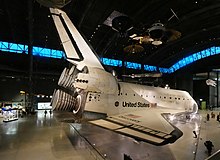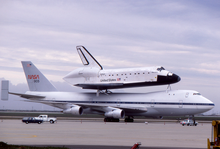| Discovery | |
|---|---|
 Discovery in orbit in 2011, during STS-133, the orbiter's final flight | |
| Type | Spaceplane |
| Class | Space Shuttle orbiter |
| Eponym | |
| Serial no. | OV-103 |
| Owner | NASA |
| Manufacturer | Rockwell International |
| Specifications | |
| Dry mass | 78,000 kilograms (172,000 lb) |
| Rocket | Space Shuttle |
| History | |
| First flight |
|
| Last flight |
|
| Flights | 39 |
| Flight time | 8,783 hours |
| Travelled | 238,539,663 kilometres (148,221,675 mi) around Earth[1] |
| Orbits | 5,830 around Earth |
| Fate | Retired |
| Location |
|
| Space Shuttle orbiters | |



Space Shuttle Discovery (Orbiter Vehicle Designation: OV-103) is a retired American Space Shuttle orbiter. The spaceplane was one of the orbiters from NASA's Space Shuttle program and the third of five fully operational orbiters to be built.[2] Its first mission, STS-41-D, flew from August 30 to September 5, 1984. Over 27 years of service it launched and landed 39 times, aggregating more spaceflights than any other spacecraft to date. The Space Shuttle launch vehicle had three main components: the Space Shuttle orbiter, a single-use central fuel tank, and two reusable solid rocket boosters. Nearly 25,000 heat-resistant tiles cover the orbiter to protect it from high temperatures on re-entry.[3]
Discovery became the third operational orbiter to enter service, preceded by Columbia and Challenger.[4] After the Challenger and Columbia accidents, Discovery became the oldest surviving orbiter. It embarked on its final mission, STS-133, on February 24, 2011, and touched down for the last time at Kennedy Space Center on March 9,[5] having spent a cumulative total of nearly a full year in space. Discovery performed both research and International Space Station (ISS) assembly missions, and also carried the Hubble Space Telescope into orbit among other satellites.
Discovery was the first operational shuttle to be retired, followed by Endeavour and then Atlantis. The shuttle is now on display at the Steven F. Udvar-Hazy Center of the Smithsonian National Air and Space Museum.
- ^ NASA (October 2010). "NASAfacts Discovery (OV-103)" (PDF). Archived (PDF) from the original on October 26, 2010. Retrieved October 21, 2010.
- ^ NASA (2007). "Space Shuttle Overview: Discovery (OV-103)". National Aeronautics and Space Administration. Archived from the original on November 7, 2007. Retrieved November 6, 2007.
- ^ "10 Cool Facts About NASA's Space Shuttle Discovery | Space Shuttle Retirement". Space.com. April 18, 2012. Archived from the original on June 22, 2013. Retrieved August 30, 2013.
- ^ "Discovery's last mission flight to space begun". February 24, 2011. Archived from the original on July 16, 2011. Retrieved March 9, 2011.
- ^ "Discovery's Final Touchdown A Success". redOrbit.com. Archived from the original on August 20, 2011. Retrieved March 9, 2011.